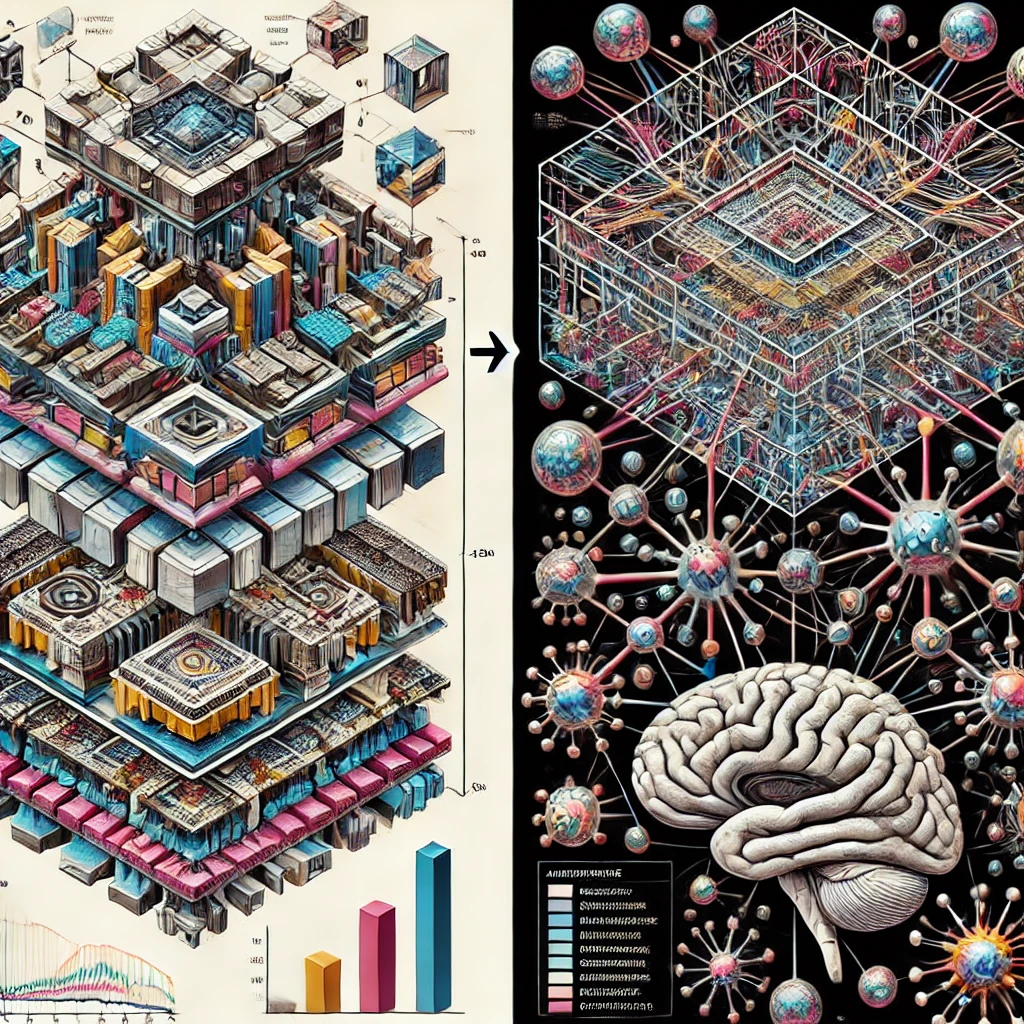Breaking Down Academic Silos
Picture this: It’s 2030, and you’re walking through Texas A&M University’s campus. In the agriculture building, Dr. Sarah Martinez is developing algorithms to predict crop diseases using satellite imagery. Three buildings over, a veterinary scientist studies livestock health patterns. Across campus, an engineering professor designs precision agriculture equipment while a geosciences researcher analyzes climate data.
Today, these brilliant minds work in isolation. Their datasets remain locked in departmental silos. Their insights never cross-pollinate. But what if there was a different way?
Cross-College Collaboration
Dr. Martinez has always wondered about the connection between livestock health and crop contamination—a question that sits at the intersection of her field and veterinary medicine. Through an AI Research Consortium, she gains access to veterinary datasets on livestock health patterns.
The discovery is remarkable: certain livestock diseases predict crop contamination events weeks before traditional agricultural monitoring detects them. Her crop disease prediction models become exponentially more powerful when informed by animal health data.
This isn’t just academic curiosity—it’s a breakthrough that could prevent billions in agricultural losses and protect food safety for millions.
Meanwhile, Dr. James Chen in engineering has been developing AI systems for manufacturing quality control. His algorithms excel at detecting microscopic defects in precision equipment. Dr. Lisa Rodriguez in the medical school works on AI for medical imaging, trying to identify early-stage cancers that human radiologists might miss.
Through the consortium platform, they discover something unexpected: Dr. Chen’s manufacturing defect detection algorithms, when adapted for medical imaging, can identify cancerous tissues with unprecedented accuracy. Dr. Rodriguez’s medical imaging techniques, in turn, improve Dr. Chen’s quality control systems.
The result? Manufacturing systems that produce higher-quality medical devices, and diagnostic tools that save lives by catching diseases earlier than ever before.
The Netflix Model for Academic Knowledge
The AI Research Consortium operates on a fundamentally different principle than traditional technology transfer. Instead of licensing individual technologies to single companies, it creates a subscription-based ecosystem where knowledge flows continuously between academia and industry.
Think Netflix, but for university AI research.
Faculty members no longer work in departmental silos. They contribute their datasets and algorithms to the consortium while gaining access to resources from across the university. A single researcher can now leverage the combined knowledge of multiple colleges, creating innovations that would be impossible within traditional academic boundaries.
Graduate students work on projects that span disciplines, gaining experience in collaborative innovation while contributing to real-world solutions. They graduate not just as experts in their fields, but as innovators who understand how knowledge from different domains can combine to solve complex problems.
For Industry: From One-Time Purchases to Ongoing Innovation
Companies no longer license individual technologies and hope they work in isolation. Instead, they subscribe to the consortium platform, gaining access to continuously updated algorithms, datasets, and expertise from multiple disciplines.
An agricultural technology company might subscribe to access not just agricultural algorithms, but also veterinary data for livestock integration, engineering models for equipment optimization, and climate data for environmental planning. They receive ongoing updates as university research advances, ensuring their products remain at the cutting edge.
The Movement Has Already Begun
The consortium model isn’t just theoretical. Early examples are emerging:
OpenAI’s NextGenAI Consortium: In March 2025, OpenAI launched a $50 million research consortium with 15 leading research institutions, including Duke University and Ohio State University. This first-of-its-kind partnership aims to use AI to accelerate research breakthroughs and transform education across disciplines. University of Alabama Huntsville: UAH has developed a cross-college collaboration that created a self-learning AI platform for drug discovery, combining expertise from multiple departments. Dutch CVON-AI Consortium: The Netherlands established the CVON-AI research consortium to enhance cardiovascular AI research through collaborative partnerships between universities and research institutions.These examples prove the concept works—and they’re just the beginning.
The Competitive Advantage Universities Possess
No commercial AI company can replicate the depth and breadth of expertise that exists within a comprehensive research university. While tech companies might excel in specific domains, universities possess knowledge across virtually every field of human endeavor.
When these diverse knowledge bases combine through AI Research Consortiums, they create competitive advantages that no single company or even industry consortium can match.
Universities operate on longer time horizons than most commercial entities. While companies focus on quarterly results, universities can invest in research that might take years or decades to reach fruition. This long-term perspective enables the development of foundational technologies that create entirely new industries.
Universities’ educational and research missions align with providing accessible, high-quality solutions rather than maximizing short-term profits. This mission alignment creates trust with both researchers and industry partners, enabling collaborations that might be impossible in purely commercial contexts.
The Human Stories Behind the Vision
Remember Dr. Park from Part 1, struggling to commercialize his manufacturing AI research? In a university with an AI Research Consortium, his algorithms for predicting equipment failures don’t exist in isolation—they’re enhanced by medical data on device reliability, agricultural data on machinery performance, and geosciences data on environmental impacts.
His research has evolved from a narrow engineering application to a comprehensive platform for predictive maintenance across multiple industries. Companies subscribe to access his continuously updated algorithms, and he receives ongoing royalties that fund expanded research. Most importantly, his work prevents equipment failures that could cause injuries, environmental damage, and economic losses.
Lisa, the entrepreneur who struggled to access university technologies for her agricultural startup, now operates in an ecosystem where university AI resources are readily available through consortium platforms. Instead of spending years developing algorithms from scratch, she can focus on understanding farmer needs and creating user-friendly applications.
Her company grows rapidly because it’s built on the foundation of decades of university research from multiple disciplines. She collaborates directly with university researchers, providing real-world feedback that improves their algorithms while benefiting from their ongoing innovations.
The Global Competition Reality
While American universities debate incremental improvements to technology transfer, other countries are building comprehensive innovation ecosystems that leverage their research institutions more effectively.
China’s universities increasingly operate as integrated innovation platforms where research from multiple disciplines combines to create commercial applications. Singapore’s research institutions function as bridges between academic research and commercial application. Germany’s innovation ecosystem includes institutions specifically designed to translate academic research into commercial applications.
American universities still lead in research quality and innovation, but this advantage isn’t guaranteed. The AI Research Consortium model represents America’s opportunity to maintain and extend its innovation leadership by more effectively leveraging the unique advantages of comprehensive research universities.
The Network Effects of Success
Universities that move first to create AI Research Consortiums will gain significant advantages through network effects. The first consortiums will attract the best researchers, the most innovative companies, and the largest datasets. Success will breed success as universities with thriving consortiums become magnets for talent and investment.
But these network effects also mean that universities that wait too long may find themselves permanently disadvantaged. The consortium revolution will likely produce a few dominant platforms rather than many small competitors.
Looking Ahead: The Transformation Potential
The AI Research Consortium model represents more than technological innovation—it’s about reimagining the university as a collaborative ecosystem where knowledge from different disciplines combines to create solutions that no single field could develop alone.
In Part 3 of this series, we’ll explore what this transformation could look like in practice—painting a picture of universities that have successfully implemented AI Research Consortiums and examining the broader implications for higher education, innovation, and society.
The consortium revolution could transform how knowledge flows between academia and industry, how colleges collaborate within universities, and how research institutions contribute to economic growth and social progress. It represents a future where the artificial boundaries between academic disciplines dissolve, replaced by collaborative innovation that addresses real-world challenges.
The question isn’t whether this transformation will happen—it’s whether American universities will lead it or follow others who embrace this vision first.
Coming Next: Part 3 – “The Future of University Innovation: When AI Research Becomes Economic Engine” – A vision of what universities could become when they embrace the AI Research Consortium transformation and the broader implications for society.
References







